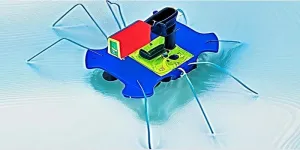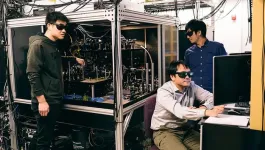(Press-News.org) INGHAMTON, N.Y. -- Researchers at Binghamton University, State University of New York have developed a self-powered “bug” that can skim across the water, and they hope it will revolutionize aquatic robotics.
Futurists predict that more than one trillion autonomous nodes will be integrated into all human activities by 2035 as part of the “internet of things.” Soon, pretty much any object — big or small — will feed information to a central database without the need for human involvement.
Making this idea tricky is that 71% of the Earth’s surface is covered in water, and aquatic environments pose critical environmental and logistical issues. To consider these challenges, the U.S. Defense Advanced Research Projects Agency (DARPA) has started a program called the Ocean of Things.
Over the past decade, Binghamton University Professor Seokheun “Sean” Choi— a faculty member at the Thomas J. Watson School of Engineering and Applied Science’s Department of Electrical and Computer Engineering and director of the Center for Research in Advanced Sensing Technologies and Environmental Sustainability (CREATES) — has received research funding from the Office of Naval Research to develop bacteria-powered biobatteries that have a possible 100-year shelf life. Choi, along with Anwar Elhadad, PhD ’24, and PhD student Yang “Lexi” Gao, developed the self-powered bug.
The new aquatic robots use similar technology because it is more reliable under adverse conditions than solar, kinetic or thermal energy systems. A Janus interface, which is hydrophilic on one side and hydrophobic on the other, lets in nutrients from the water and keeps them inside the device to fuel bacterial spore production.
“When the environment is favorable for the bacteria, they become vegetative cells and generate power,” he said, “but when the conditions are not favorable — for example, it’s really cold or the nutrients are not available — they go back to spores. In that way, we can extend the operational life.”
The Binghamton team’s research showed power generation close to 1 milliwatt, which is enough to operate the robot’s mechanical movement and any sensors that could track environmental data such as water temperature, pollution levels, the movements of commercial vessels and aircraft, and the behaviors of aquatic animals.
Being able to send the robots wherever they are needed is a clear upgrade from current “smart floats,” which are stationary sensors anchored to one place.
The next step in refining these aquatic robots is testing which bacteria will be best for producing energy under stressful ocean conditions.
“We used very common bacterial cells, but we need to study further to know what is actually living in those areas of the ocean,” Choi said. “Previously, we demonstrated that the combination of multiple bacterial cells can improve sustainability and power, so that’s another idea. Maybe using machine learning, we can find the optimal combination of bacterial species to improve power density and sustainability.”
END
Self-powered ’bugs’ can skim across water to detect environmental data
Devices could run on ocean bacteria and revolutionize aquatic robotics
2024-07-29
ELSE PRESS RELEASES FROM THIS DATE:
NASA data shows July 22 was Earth’s hottest day on record
2024-07-29
July 22, 2024, was the hottest day on record, according to a NASA analysis of global daily temperature data. July 21 and 23 of this year also exceeded the previous daily record, set in July 2023. These record-breaking temperatures are part of a long-term warming trend driven by human activities, primarily the emission of greenhouse gases. As part of its mission to expand our understanding of Earth, NASA collects critical long-term observations of our changing planet.
“In a year that has been the hottest on record to date, these past two weeks have ...
Prestigious NIH award will advance brain research at UCR
2024-07-29
RIVERSIDE, Calif. -- A National Institutes of Health grant received by Vijayalakshmi (Viji) Santhakumar, a professor of molecular, cell and systems biology at the University of California, Riverside, has been selected for the prestigious Javits Neuroscience Investigator Award, the first time for the campus.
The five-year, $3.5 million grant from the National Institute of Neurological Disorders and Stroke, or NINDS, of the National Institutes of Health is a collaborative study with Edward Zagha, an associate professor of psychology at UCR. The award will support research into how brain circuits contribute to episodic memory formation and how ...
Purdue researchers trap atoms, forcing them to serve as photonic transistors
2024-07-29
Researchers at Purdue University have trapped alkali atoms (cesium) on an integrated photonic circuit, which behaves like a transistor for photons (the smallest energy unit of light) similar to electronic transistors. These trapped atoms demonstrate the potential to build a quantum network based on cold-atom integrated nanophotonic circuits. The team, led by Chen-Lung Hung, associate professor of physics and astronomy at the Purdue University College of Science, published their discovery in the American Physical Society’s Physical Review X.
“We developed a technique to use lasers ...
Analogies for modeling belief dynamics
2024-07-29
Researchers who study belief dynamics often use analogies to understand and model the complex cognitive–social systems that underly why we believe the things we do and how those beliefs can change over time. Ideas can be transmitted like a virus, for instance, “infecting” a population as they spread from person to person. We might be drawn — like magnets — to others with a similar worldview. A society’s beliefs can shift slowly before reaching a tipping point that thrusts society into a new phase.
In a new paper in Trends in Cognitive Sciences, SFI Professor Mirta Galesic and ...
Many juvenile ‘lifers’ freed
2024-07-29
In 1953, 15-year-old Joe Ligon and four other Pennsylvania teens went on an alcohol-fueled tear that resulted in the stabbing deaths of two people and injuries to six more.
The teens were tried as a group, and all received life without parole.
After a series of U.S. Supreme Court decisions in 2012 and 2016 found that mandatory life sentences for juveniles was unconstitutional, Ligon’s case went to federal court. After 67 long years in prison, the case was decided in his favor in 2020.
Ligon was granted his freedom in 2021 — at 83 years of age and after ...
UW model shows cortical implants like Elon Musk’s Blindsight unlikely to ‘exceed normal human vision’
2024-07-29
Elon Musk recently declared on X that Blindsight, a cortical implant to restore vision, would have low resolution at first “but may ultimately exceed normal human vision.”
That pronouncement is unrealistic at best, according to new research from the University of Washington.
Ione Fine, lead author and UW professor of psychology, said Musk’s projection for the latest Neuralink project rests on the flawed premise that implanting millions of tiny electrodes into the visual cortex, the region of the brain that processes information received from the eye, will result in high-resolution vision.
For the study, ...
UVA's Data Justice Academy receives new funding from NSF
2024-07-29
The National Science Foundation will provide funding to the University of Virginia’s Data Justice Academy, the agency recently announced, support that will help the summer program continue to serve undergraduate students from groups that are historically underrepresented in data science.
Established in 2021, the Data Justice Academy provides a 10-week residential experience to participants in which they perform mentored research while learning technical skills.
The overriding goal of the Data Justice Academy, which is jointly managed by UVA’s School of Data Science and Equity Center, ...
Orthopedic surgeon-scientist Dr. Frank Henn named Chair of the Department of Orthopaedics
2024-07-29
University of Maryland School of Medicine (UMSOM) Dean Mark T. Gladwin, MD, announced today that R. Frank Henn, III, MD, Professor of Orthopaedics, who has served as Interim Chair of the Department since 2022, has been appointed to serve as the new Chair of UMSOM’s Department of Orthopaedics, effective immediately.
Dr. Henn, who joined the Department in 2010, is an academic leader and highly regarded, board-certified orthopaedic surgeon; he has published significant scientific research, and is a leading clinician focusing on the care of the shoulder and knee, with an emphasis in cartilage ...
Nature inspires a breakthrough: scientists develop revolutionary egg white-based bioink for advanced tissue engineering
2024-07-29
Los Angeles, California – July 29, 2024 - Terasaki Institute scientists have created a cutting-edge technology inspired by nature by developing a novel bioink derived from egg whites or Egg White methacryloyl (EWMA). Bioinks are mainly used in 3D bioprinting to create artificial tissues. These natural or synthetic materials support living cells, aiding their adhesion, growth, and differentiation. They are essential for developing complex tissue structures for medical research, drug testing, and organ transplantation. This novel EWMA bioink represents a promising addition to this field, offering a unique combination of properties that address many challenges faced in tissue engineering.
The ...
California a botanical and climate change hot spot
2024-07-29
From coastal redwoods and Joshua trees to golden poppies and sagebrush, California is a global botanical hotspot. It’s also a place confronted with extreme heat, wildfires and crumbling coastlines. The state’s natural beauty and history of pioneering conservation efforts make it a test bed for protecting biodiversity in the face of current and future climate change, argues a study led by the University of California, Davis.
Published July 29 in Proceedings of the National Academy of Sciences, the study, “Climate Change and California’s Terrestrial Biodiversity,” is part of a special ...
LAST 30 PRESS RELEASES:
Heart-brain connection: international study reveals the role of the vagus nerve in keeping the heart young
Researchers identify Rb1 as a predictive biomarker for a new therapeutic strategy in some breast cancers
Survey reveals ethical gaps slowing AI adoption in pediatric surgery
Stimulant ADHD medications work differently than thought
AI overestimates how smart people are, according to HSE economists
HSE researchers create genome-wide map of quadruplexes
Scientists boost cell "powerhouses" to burn more calories
Automatic label checking: The missing step in making reliable medical AI
Low daily alcohol intake linked to 50% heightened mouth cancer risk in India
American Meteorological Society announces Rick Spinrad as 2026 President-Elect
Biomass-based carbon capture spotlighted in newly released global climate webinar recording
Illuminating invisible nano pollutants: advanced bioimaging tracks the full journey of emerging nanoscale contaminants in living systems
How does age affect recovery from spinal cord injury?
Novel AI tool offers prognosis for patients with head and neck cancer
Fathers’ microplastic exposure tied to their children’s metabolic problems
Research validates laboratory model for studying high-grade serous ovarian cancer
SIR 2026 delivers transformative breakthroughs in minimally invasive medicine to improve patient care
Stem Cell Reports most downloaded papers of 2025 highlight the breadth and impact of stem cell research
Oxford-led study estimates NHS spends around 3% of its primary and secondary care budget on the health impacts of heat and cold in England
A researcher’s long quest leads to a smart composite breakthrough
Urban wild bees act as “microbial sensors” of city health.
New study finds where you live affects recovery after a hip fracture
Forecasting the impact of fully automated vehicle adoption on US road traffic injuries
Alcohol-related hospitalizations from 2016 to 2022
Semaglutide and hospitalizations in patients with obesity and established cardiovascular disease
Researchers ‘listen in’ to embryo-mother interactions during implantation using a culture system replicating the womb lining
How changing your diet could help save the world
How to make AI truly scalable and reliable for real-time traffic assignment?
Beyond fragmented markets: A new framework for efficient and stable ride-pooling
Can shape priors make road perception more reliable for autonomous driving?
[Press-News.org] Self-powered ’bugs’ can skim across water to detect environmental dataDevices could run on ocean bacteria and revolutionize aquatic robotics









